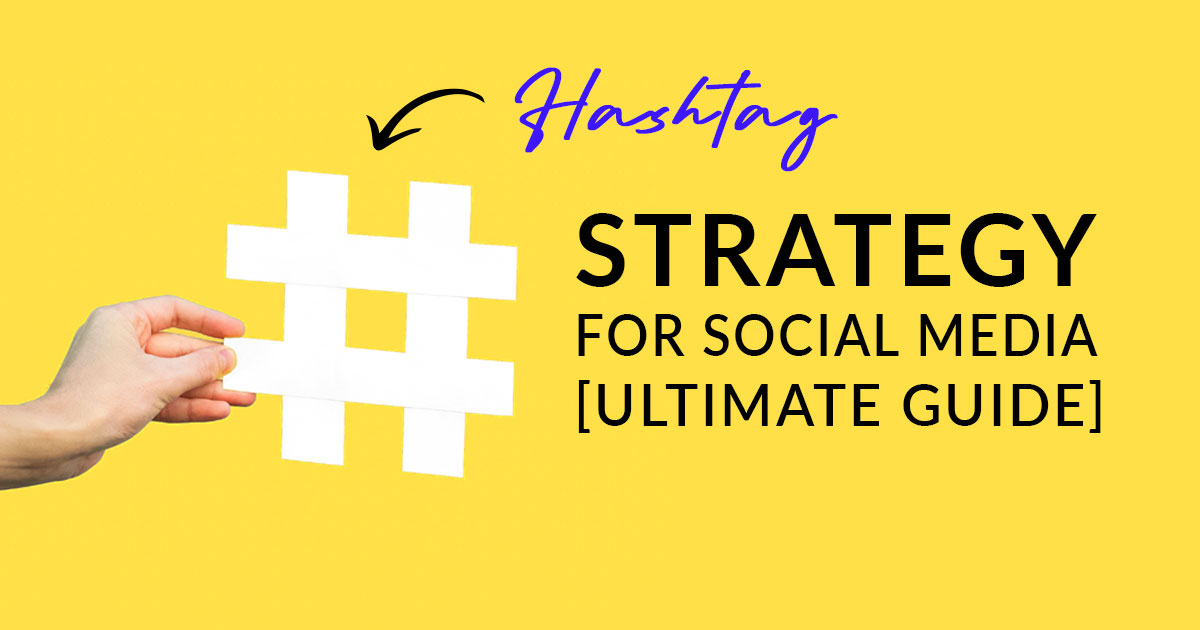Updated: March 2023
TL;DR: If you’ve got a hashtag strategy you’ve been using, you may have to rethink it after Instagram’s 2022 announcement. Rather than being used to gain exposure, hashtags now seem to serve primarily as a categorization tool. Instagram and, potentially, other platforms may favour keywords over hashtags as a ranking tool.
That’s a bit of a switch, but it’s not a bad one if you change your hashtag strategy accordingly. To give you a head start, we will go through the ABCs of hashtags, answer frequently asked questions, and share tips that can help hashtag newbies, virtuosos, and anyone in between to optimize their 2023 hashtag strategy.
Let’s start from the beginning. What’s a hashtag?
A hashtag is a word or phrase with no spaces or punctuation that is preceded by a ‘#’ symbol. Some examples are:
- #dance
- #basketweaving
- #puppies
- #NYC
- #sorrymom
- #iforgottodefrostthechicken
- #pleasedontbemad
- #justkiddingimvegetarian
- #andilivealone
…and the list goes on!
Since their inception, hashtags have been used to organize content by topic. Social media platforms like Instagram and Facebook don’t have eyes, so they can’t look at your post and immediately categorize it based on the image alone (although AI might change that soon).
Hashtags are a tool to “describe” your post to platforms so that users can readily find what they seek.
Think of your social media posts as spice jars and hashtags as labels. In order to prevent using two cups of salt in your cookie recipe instead of sugar, you need to either:
a) Do a taste test or
b) label your jars correctly
Since Instagram or Facebook cannot “taste” your posts, they simply use the labels that you’ve assigned to get an idea of what they’re about. This is why when you search the #pumpkinspicelatte hashtag on Instagram, you are greeted with the quintessential fall beverage that we know and love, and not a picture of some dude’s infected toenail.

So now you know the ‘what’ and the ‘how’ but not the ‘why.’ Why use hashtags at all?
Whether you are using Instagram as a way to show off your extensive Squishmallow collection or as a marketing tool to attract prospective clients, hashtags are worth your time. Here are four reasons why.
#1: Make Your Content More Visible
You’ve seen that users can find relevant content by searching hashtags, so applying the right ones can make you more visible to your target audience. If your account is all about plant care, using hashtags like #plantcaretips or #plantmom will attract fellow flora fanatics to your posts and, in turn, your account.
The simple answer is yes, hashtags can help your content rank higher, but that may be changing even as you read this!
Instagram’s ranking algorithm is multifaceted – they’ve said it themselves. The algorithm considers:
- The amount of engagement generated by a post (i.e., how many likes, comments, shares, and saves a post receives)
- How recently was a post made
- The type of post (photo or video)
- The type of content a user typically engages with (Do they prefer photos or videos? What are their interests or niches?)
Instagram’s algorithm uses this information to determine how posts will appear in a user’s feed. In other words, it uses this information to rank content.
So, where do hashtags fit into this story?
Instagram Explore Page
I’ve already mentioned that hashtags are a great way to find content related to your interests. The more you engage with posts that have certain hashtags, the more Instagram’s algorithm understands what you like. For example, if you engage with many posts under the #TimotheeChalamet hashtag, his face will likely be all over your Instagram Explore page (yes, this is from personal experience).
The Instagram Explore page contains public photos, videos, Reels, and Stories tailored to help every Instagram user find posts, accounts, hashtags, and products they might be interested in.
Once upon a time, hashtags were considered the ticket to user Explore pages, but as we will explore (pun intended) later, this seems to no longer be the case.
#2: Build Your Brand
Consumers can use hashtags to learn more about your product or service via social media. They can also give people a chance to share their thoughts about your brand, and consumers trust other consumers more than brands. If you do sponsorships with influencers, they can use these hashtags to generate conversations about your product or service.
A hashtag can become the default thing a consumer associates with your company, much like a slogan in traditional advertising. For example, Bell and #BellLetsTalk. Pick a digital slogan/hashtag that resonates and you can become part of the conversation!
#3: Connect with People in Your Niche
Too anxious to attend your local anime club? Lucky for you, hashtags are an easy way to find people in your niche. Later on, we will discuss niche, community, and location hashtags, which are all crucial to finding comrades (not THOSE comrades…unless that’s your vibe 🤷🏼♀️).
#4: Participate in Local and Global Conversations
Searching and using hashtags are quick and easy ways to participate in global and local conversations. They attract like-minded and oppositional people alike. This is what Himelboim et al. refer to as “polarized clusters.” In other words, hashtags generate highly divisive discourse between individuals and groups.
For example, in late 2020, #elxn44 was used for the 44th U.S. presidential election. Scrolling through this hashtag for mere seconds was enough to gauge the polarization of the election. Using political hashtags will inevitably attract strong opinions, so use them carefully!
Hashtags do more than connect you with fellow crocheters or pet parents. They can also incite pivotal social change and spark important debates and conversations. In fact, some movements have relied on the proliferation of certain hashtags to elevate marginalized voices.
Some prominent hashtags from social movements are:
- #BlackLivesMatter
- #MeToo
- #EveryChildMatters
- #MMIW (Missing and Murdered Indigenous Women)
Educating yourself on social issues is an important part of supporting a community, and sifting through these hashtags can be an excellent way to do just that.
Various types of hashtags are available for a wide variety of users. I’ve broken down a few types of hashtags below:
Brand hashtags are used by companies or personal brands (like bloggers, for instance). They serve a few different functions:
- To allow consumers to participate in conversations about a company or brand.
- Create a memorable association between a company and goods and services.
- For influencers to reveal sponsorships from brands.
Based on these functions, brand hashtags can include:
- The name of your brand (ex: #nyxcosmetics).
- The name of your brand + a call-to-action that captures your brand’s goals (ex: #BellLetsTalk).
- A call-to-action that captures your brand’s goals without including the brand name (ex: #justdoit). Oftentimes, this would also be your brand’s slogan.
To illustrate how brand hashtags work, we will use one of our clients, FreightNav, and the hashtags we created for them.
#FreightNav is a basic brand hashtag that only includes the company’s name.
Since it is the name of a business, it is unlikely that anyone would search for it other than its employees or consumers who want to leave a review about its services. This hashtag doesn’t tell us anything about the company or its goals.
#FreighNavEmpowers uses the company’s name and includes a verb that captures their main goal – to empower shippers and carriers to work with each other directly. By using these hashtags, brands can be linked to a particular goal, so every time someone thinks of FreightNav, they can be reminded that empowerment is one of their core values.
While hashtags like #empowershippers and #empowercarriers do not contain FreightNav’s name, they have still branded hashtags because they capture the company’s goals. These hashtags should be used consistently on a company’s social media channels, with the goal being a favourable ranking for that term.
Community hashtags can be considered inside jokes between people in a particular niche. People outside of specific niches or fandoms don’t tend to use them as often. Some examples include:
- #hikemoreworryless (for hikers)
- #filmisnotdead (for people who shoot film)
- #skateeverydamnday (for skateboarders and rollerbladers)
- #potterhead (for Harry Potter fans)
- #pothead (for hash n’ pot fans)
- #BTSarmy (for BTS
fansstans)
These hashtags are a combination of brand and community hashtags, where fans of a brand come together to celebrate products and services. Some notable brand community hashtags include:
- #mygopro (used to showcase photography taken on GoPro products)
- #mycalvins (people feeling confident in their Calvin Klein underwear)
- #hypebeast
With the first two examples, the hashtags encourage consumers to share their experiences by using “my.”
The last example is the name of a men’s fashion magazine but has also been adopted as a term for diehard fans of popular or “hype” clothing and footwear.
Niche hashtags contextualize your brand’s industry or capture your personal interests. You can pop a “#” in front of virtually any and every activity on earth and voila, you’ve got a niche hashtag. Examples include:
- #pottery
- #cosplay
- #digitalmarketing
- #gaming
These hashtags can also describe your work or your hobbies:
- #copywriter
- #trucker
- #ceramicartist
- #girlgamer
As the name implies, these hashtags describe your audience. And no, we don’t mean hashtags that describe irrelevant physical attributes like your audience’s hair colour (unless you’re marketing hair dye) or shoe size (unless you’re selling orthopedic footwear in unconventional sizes).
These hashtags typically assign titles to audience members based on their occupation, hobby, interests, marital status, parental status, etc. Some examples are:
- #trucker
- #gymrat
- #singlemom
- #hypebeast
By using the tags that best describe your audience, you can increase exposure for your posts and gain new customers or followers in the process.
These hashtags refer to a product being marketed or mentioned. Using product-descriptive hashtags can help your target audience find your brand more easily, even if they have never heard of it before.
Examples:
- #blockprintshirts
- #hairaccessory
- #mousepad
- #contraceptives
Location hashtags can either be standard place names like #Ontario, #Hamilton, and #Canada, or they can be region-specific nicknames like #HamOnt, #The6ix, and #TurtleIsland. The latter examples integrate community with location, making them more likely to be used by people living in those areas.
Location hashtags are great for brands catering to local audiences or audiences in a specific area. If you want to get even more specific, location can be combined with niche (ex: #canadianblogger, #pennsylvaniaphotography, #nigerianfoodie).
Event hashtags can reference current, past, upcoming, or recurring events. Event hashtags usually peak during specific times and decline afterward, especially if they reference a year or a one-time-only occurrence.
Some notable event hashtags:
- #superbowl50
- #fifaworldcup
- #sandiegowildfire
- #oktoberfest2019
- #corgimeetup
As these hashtags are not as specific as brand or community hashtags, they appeal to a much broader audience with various perspectives. For instance, #nbafinals would attract fans of different participating basketball teams, whereas #WeTheNorth would likely only attract Raptors fans.
Also known as ‘hashtag activism,’ social movement hashtags are used to show support for a cause by sharing certain issues with friends and followers. The goal is to encourage widespread discussion and hopefully incite change.
Notable examples:
- #BlackLivesMatter
- #EveryChildMatters
- #NoMoreStolenSisters
- #TimesUp
2023 Instagram Hashtag Strategy: Dos
You’ve done your homework and learned all the hashtag strategy jargon. Now it’s time to use all that information to up your hashtag game! Here are some tips to get you started.
Create a Hashtag Vault
With a hashtag vault, you can organize all of the hashtags you want to use for your brand’s social media posts. This includes popular hashtags relevant to your brands and branded tags you’ve come up with yourself. You can then create a colour-coded spreadsheet (yes, it is that serious) that lists hashtags by type, popularity, and intended audience.
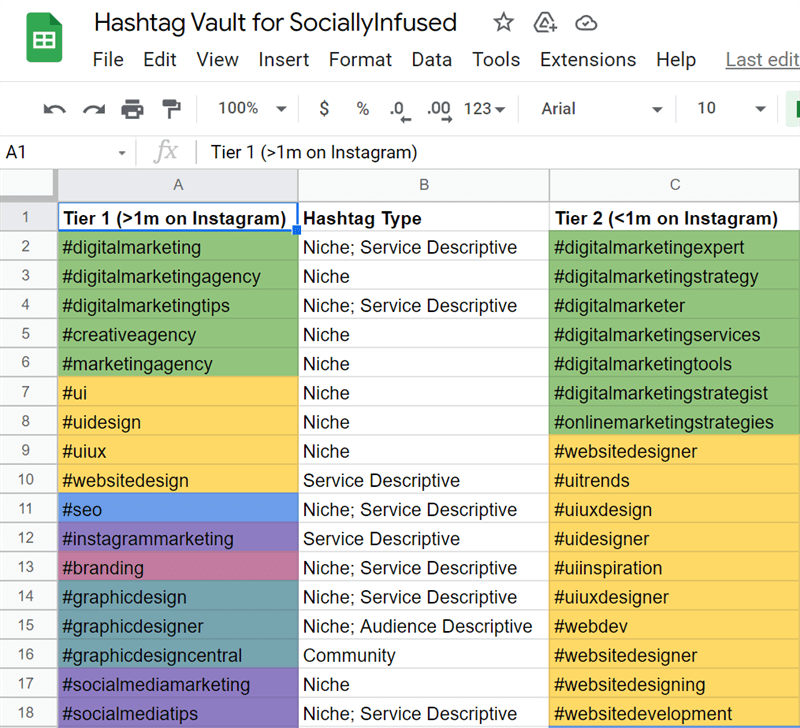
Instagram Hashtag Tiers
Instagram hashtags can be categorized by how many times they’ve been used on the platform. We’ve divided Instagram hashtags into four tiers of popularity.
- Tier 1: a hashtag that has been used on over 1 million Instagram posts (ex: #travelblogger)
- Tier 2: a hashtag that has been used on over 100,000 Instagram posts, but less than 1 million (#offthebeatenpath)
- Tier 3: a hashtag that has been used on less than 100,000 Instagram posts (#ontariohikes)
To optimize your discoverability on Instagram, use a combination of hashtags from the three tiers while keeping them as relevant and specific to your brand as possible.
If you’re just using popular, general hashtags in hopes of directing traffic to your page, it doesn’t tell users anything about your brand, and people can see through that.
Experiencing some hashtag writer’s block? There are many tools to generate popular and niche hashtags that already exist. They include:
…and so many more. Experiment with some hashtag generators to find which one works for you.
Use a Variety of Hashtag Types
Use a variety of appropriate hashtags in your posts. This is easy when you have a hashtag vault!
A hashtag may have been used over 1 million times, but this does not mean it was done recently (#Kony2012 anyone?).
Check the date on the top posts of a hashtag to make sure it’s still relevant today. You are unlikely to get exposure for your post if all the top posts were made years ago.
Although it may be tempting to include the same few hashtags with every post, it’s not recommended. This behaviour may be seen by Instagram as “spammy” and result in a shadowban.
Is Shadow Banning Real?
Shadow banning involves partially blocking or censoring a user’s content to be less accessible (or not accessible at all). Shadow-banned accounts don’t appear on Instagram explore pages, and engagement on their posts can drop. Think of it as the social media version of a cold shoulder.
Instagram’s CEO has denied that shadow banning is real, but the platform’s users suggest otherwise. To be on the safe side, we recommend switching up the order of your hashtags.
Use the Instagram Insights Tool
With a Business or Creator account, you gain access to the Instagram Insights feature. This is essential for any small business or startup.
By clicking the blue “Insights” button under your posts, you will get all kinds of stats about your engagement – who is engaging with your posts, how they find your content, how many accounts you reached, etc. If you check the ‘Reach’ section, you can check your impressions count to see how many users found your content through hashtags.
Use these insights to see which hashtags work best for your content, or if hashtags are working for you at all. If you’re not seeing engagement, you might be using hashtags that are far too general.
The Instagram Creators account recently announced that 3-5 hashtags are recommended per post.
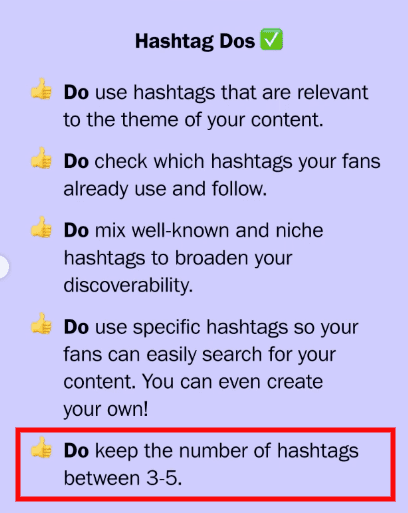
This has resulted in some confusion – and frankly, frustration – among creators and digital marketing strategists.
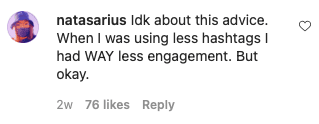
Instagram’s recommended limit for hashtags seems to be gradually decreasing. However, if only 3-5 hashtags are recommended, why is the Instagram hashtag limit of 30 per post?
Some speculate that this is to prevent bot comments since fewer hashtags will force people to select truly relevant ones. Only Instagram knows for sure!
You’re likely a pro at following your favourite accounts on Instagram. Did you know that you can do the same with hashtags? All you have to do is:
1) Type a particular hashtag in the Instagram search bar. For example, #veganrecipes
2) Hit the blue follow button
It’s as easy as that! You will now have access to content from various creators you might have otherwise missed.
Earlier, we said you won’t be confronted with someone’s toe infection while browsing the #pumpkinspicelatte hashtag. While that’s generally true, it isn’t ALWAYS the case.
In an effort to generate engagement, people often use trending hashtags on unrelated posts. This is an especially common practice with trending event hashtags like #2021olympics, #superbowl, #covid19pandemic, or when Netflix releases another absolute banger (think #SquidGame).
This hashtag strategy can work, but Instagram advises against it. For starters, hashtags like #explorepage, #igdaily, and #likeforlike have been used in millions billions of posts. It’s virtually impossible for your post to generate the most engagement with those hashtags – you’ve got way too much competition. You’ll also be vulnerable to spammy bot comments, and some of those make even us blush.
Remember: you want your hashtags to be specific and accurate, not just popular.
2023 Hashtag Strategy for Twitter, Facebook, LinkedIn, TikTok, and Instagram Reels
We’ve mostly discussed hashtag strategies for Instagram since we get the most questions about them. However, Instagram isn’t the only game in town. We’ll now touch upon some 2023 hashtag strategies for Twitter, Facebook, LinkedIn, TikTok, and Instagram Reels (which are slightly different from Instagram photos and videos).
Twitter Hashtag Strategy 2023
Ah, Twitter, the birthplace of the hashtag. Let’s look at how you can optimize hashtag strategy on the platform where it all began.
Twitter has recommended two hashtags per tweet for the “best practice.”
Facebook Hashtag Strategy 2023
Since Facebook’s algorithm shows posts that your friends have engaged with, digital marketers debated the value of hashtags. Although they aren’t the main way for audiences to find your Facebook content, they can help, so we recommend using hashtags on Facebook as you would on Instagram.
Since Facebook owns Instagram, we would advise following Instagram’s guidelines and sticking to 3-5 hashtags per post.
LinkedIn Hashtag Strategy 2023
Like Facebook, LinkedIn shows posts that your friends have interacted with in your feed. Therefore, hashtags are not a primary way for general audiences to find your content, but they can attract niche audiences interested in what you have to say.
Like with Facebook and Instagram, we suggest between 3-5 hashtags per post.
TikTok Hashtag Strategy 2023
TikTok’s innovative For You Page (fyp) algorithm is highly personalized. No two users’ fyps are the same because it is designed to cater to individuals’ interests – it is truly for YOU.
TikTok hashtags are used to categorize content, just like any other social media platform, and the system is eerily intuitive. Even if I spend hours scrolling through the #cottagecore hashtag without liking, commenting, sharing, or saving any videos, I’ll still be presented with videos of pretty women in flowy dresses baking muffins in the countryside. God, why can’t that be me?
If you scroll through your fyp, you’ll notice that many videos include #fyp or #ForYou in the caption. TikTok has never confirmed whether including these hashtags (or other variations) actually gets your content to people’s fyps. Just like the unspecified, overused hashtags from other platforms, there is no evidence that #fyp does anything, so focus your creative energy on relevant keywords specific to your content.
TikTok limits its captions to 100 characters, so you can’t use many hashtags even if you wanted to. You’re safe!
Instagram Reels Hashtag Strategy 2023
Remember that groundbreaking algorithm that TikTok came up with? Well, Instagram Reels has adopted a similar approach to deliver relevant content to each user’s feed.
According to Instagram, they determine which Reels to show to users based on how likely they are to:
- Watch a Reel the whole way through
- Engage with a Reel (like, comment, share, save)
- Use audio to make their own Reel
Instagram has not confirmed whether or not hashtags are important to the Reels algorithm, so some creators and marketers speculate that they’re unnecessary.
BUT, we sure think they’re necessary! If you search for a hashtag on Instagram, you’ll find three sections: top posts, recent posts, and Reels. For best results, use specific and relevant hashtags.
Hashtag Don’ts
We’ve already covered some hashtag no-nos throughout this article, but in case you missed them, here are a few tactics to omit from your 2023 hashtag strategy:
This defeats the purpose of hashtags entirely. By adding irrelevant hashtags to your post, you’re adding salt to your sugar jar, which only messes up the whole recipe.
If it’s a #cat, don’t say it’s a #frog. If it’s a #toad, don’t say it’s a #toe. If it’s #Delissio, don’t say it’s #delivery, okay?!
#love #beautiful #fashion #art #photography – these are all bound to land you some annoying bot comments or, if you’re lucky, even some MLM schemers trying to get you to sell skinny tea to your followers.
Take the extra effort to search for more niche Tier 1 hashtags, because some of these hashtags have been used billions of times.
When you search the #loseweight hashtag on Instagram, a content advisory about body image blocks out the posts behind it.
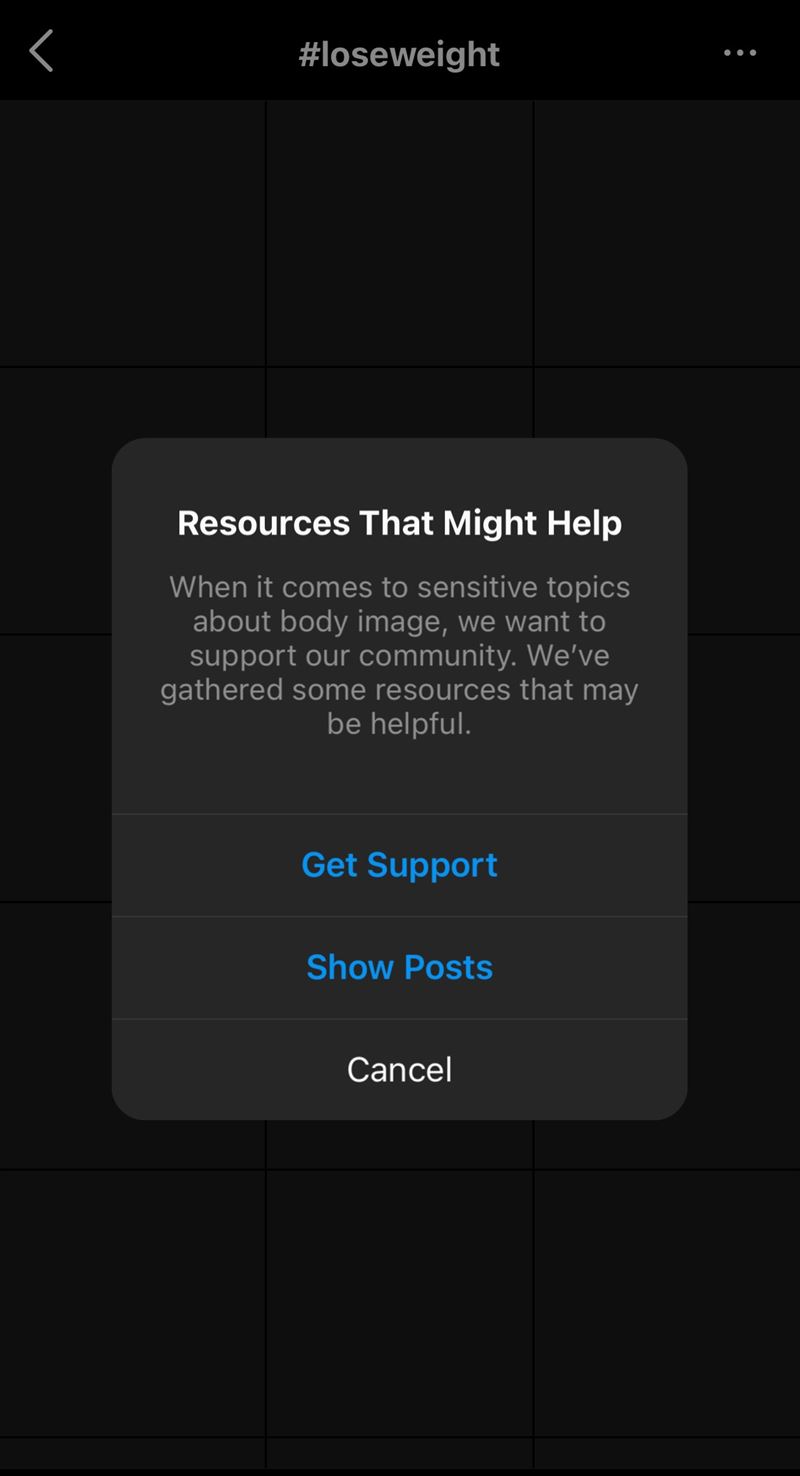
As you received an advisory, it’s safe to assume that Instagram won’t be too keen on plastering this content all over your explore page. Do your hashtag due diligence and check for a content advisory before using one.
If you hang around digital marketing specialists, you’ll hear the word “keyword” being thrown around a lot.
A keyword is a word or phrase that someone would search to find a particular type of content.
For instance, you might have searched “hashtag strategy”, “Instagram hashtags” or “how many hashtags should I use on Instagram?” to get to this article (really breaking the fourth wall here). All of those phrases are keywords, and they are at the heart of search engine optimization (SEO).
If you’re interested in some fall recipes, you might Google “fall recipes,” “recipes for fall,” “recipes with pumpkin,” “recipes for cold weather”…you get the point. If you’re looking for fall recipes on Instagram, you might include some of these keywords in the hashtags you search for, like #fallrecipe, #fallrecipes, #fallfood, #butternutsquash, etc.
However, Instagram’s ranking algorithm is always evolving, and fast. You may notice that if you search for “fall recipes” on Instagram without including our friend the ‘#’ symbol in front of it, you still get a feed full of cozy stews and pumpkin-infused treats.
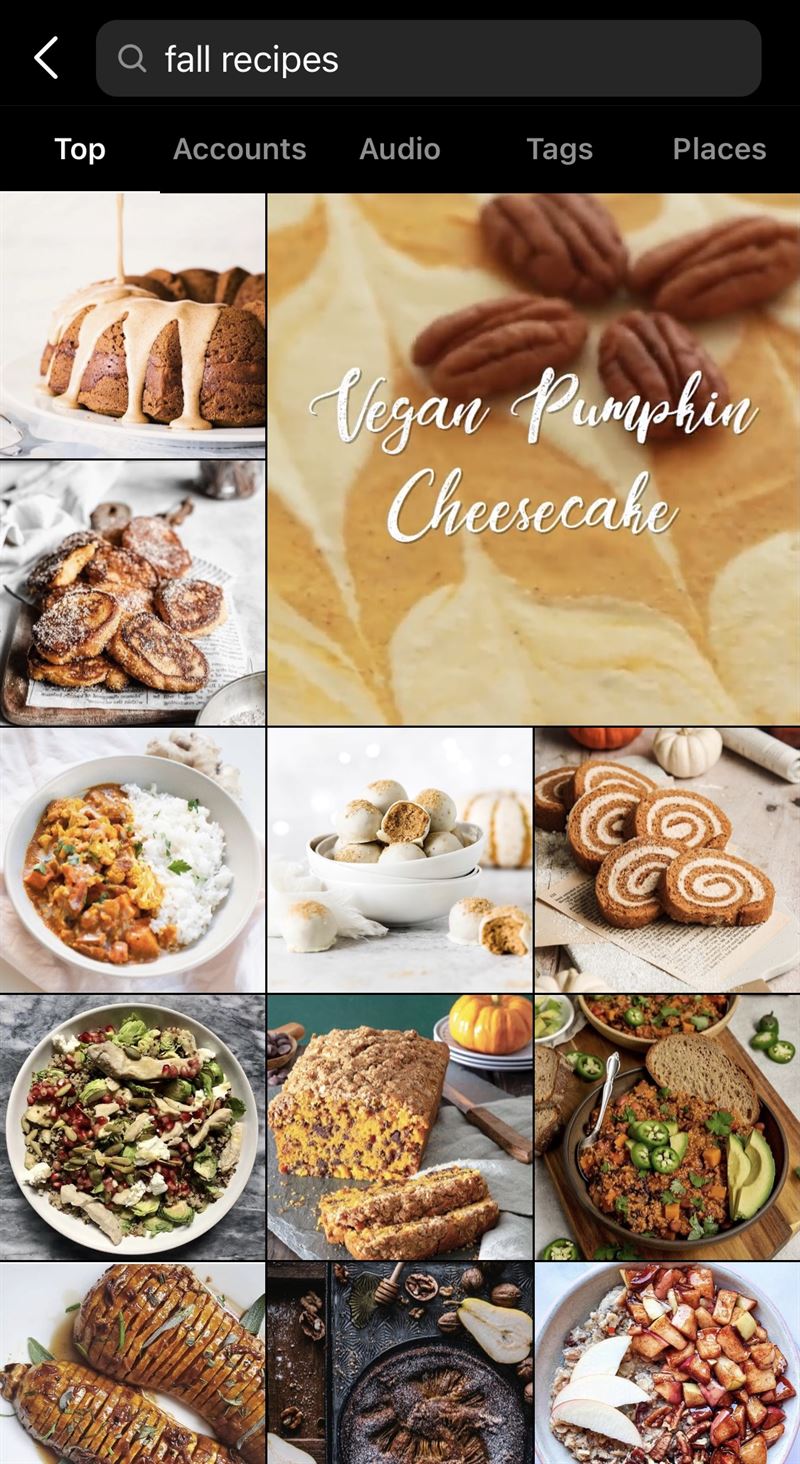
So what the #### is happening? Instagram search may now, much like Google search, also be detecting keywords in Instagram captions.
But wait.
If you can find content by searching keywords, have the hashtag death bells tolled?
Instagram’s Advice on Hashtag Usage
Instagram recently outlined strategies for using hashtags in this post. Their advice left many creators and digital marketing experts scratching their heads because it contradicted some things that Instagram has said recently. People especially took issue with the recommended number of hashtags.

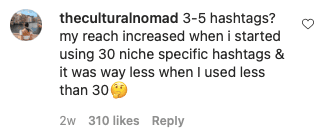
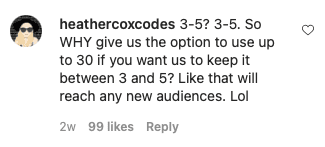
One user even speculates that this advice is a cash grab:

Some digital marketing experts have begun to speculate that Instagram is altering its algorithm to favour search over hashtags. In other words, keywords used in Instagram captions and bios may start playing a more significant role in ranking than hashtags.
If this is the case, hashtags will serve solely as tools to categorize and contextualize content, rather than helping your content get found on users’ explore pages.
SociallyInfused’s Take on Instagram’s New Hashtag Guide
As the world changes, so does Instagram’s hashtag strategy. You can expect this to happen indefinitely- or at least until humanity is wiped out by the irreversible effects of the climate crisis.
Too real?
We suggest taking Instagram’s word on the recommended number of hashtags (3-5) since it comes straight from the source.
Hashtags are still a reliable way to categorize content, so don’t give up on them completely. If the prophecy is true, and the trajectory of Instagram’s ranking strategy begins to favour keywords over hashtags, you may want to incorporate keywords in your Instagram captions and bio.
Final 2023 Hashtag Strategy Takeaways
If you’ve made it to the end of this absolute behemoth of a hashtag strategy guide, then congratulations, you’ve been officially added to my will!
Our main 2023 hashtag strategy takeaways are:
- Use specific, relevant hashtags containing keywords.
- Use a variety of hashtags – niche, community, brand, etc.
- Use 3-5 Instagram hashtags per post.
- Start using keywords in your Instagram captions and bio.
Ready for Your Own Hashtag Strategy?
Now we’ve given you the crash course on what hashtags are, how they work, and why they’re an important part of any social media marketing plan, you’ve only got one more thing to do – hook up with a digital marketing agency that can make your brand look sexy on every platform from Twitter to TikTok. If you need recommendations, we know how you can contact a good one.
